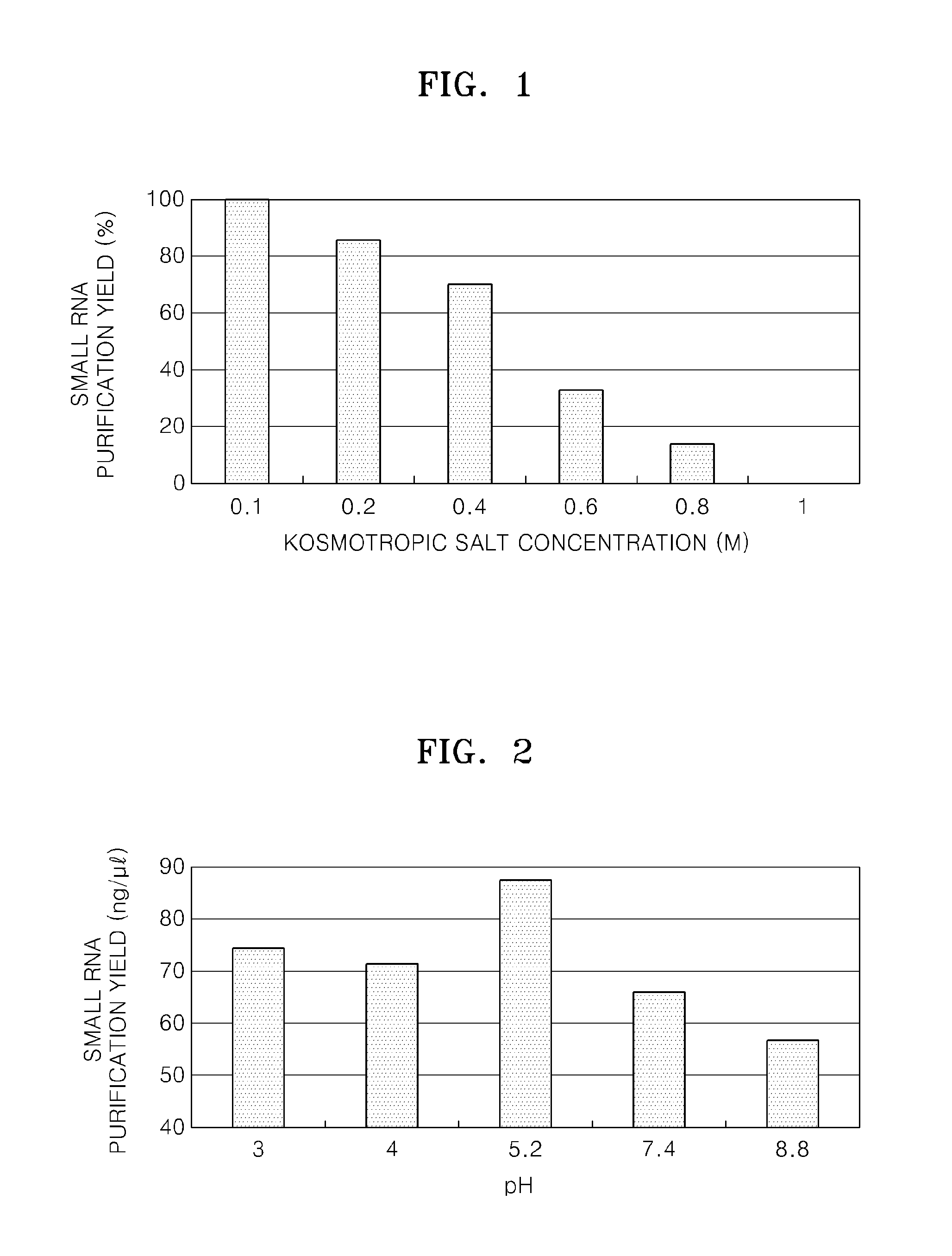Method of separating small RNA molecules using kosmotropic salt
- Summary
- Abstract
- Description
- Claims
- Application Information
AI Technical Summary
Problems solved by technology
Method used
Image
Examples
example 1
Effect of Kosmotropic Salt Concentration on Small RNA Purification
[0044]According to the protocol provided by a Qiagen™ kit (RNeasy™ Protect Bacteria Mini Kit), lysozymes and proteinase K were treated with E. coli to prepare an E. coli lysate.
[0045]200 μl of the E. coli lysate (1×108˜7.5×108 E. coli cells) was added to 1 ml of sodium sulfate (Na2SO4) solution (pH 7.4) each with different concentrations to obtain a mixture solution, and 650 μl of the mixture solution was added to a Qiagen QIAamp™ Mini spin column (silica-gel membrane column), and centrifuged at 8,000 g for 15 seconds. The column was washed with 700 μl of 10 mM Na2SO4, and washed twice with 25 mM Tris buffer including 80% ethanol (pH 7.4). The column was transferred to a new 1.5 mL Eppendorf tube, and 50 μl of DEPC (diethylpyrocarbonate)-treated water, which inactivates RNase, was added and centrifuged at 8,000 g for 1 minute to elute the total RNA. The amount of small RNAs existing within the total RNA eluate was det...
example 2
Effect of pH on Small RNA Purification
[0046]0.6M Na2SO4 was dissolved in each of 0.1M NaOAc (pH 3), 0.1M NaOAc (pH 4), 0.1M NaOAc (pH 5.2), 0.1M Tris-HCl (pH 7.4), and 0.1M Tris-HCl (pH 8.8) and the isolation process was performed as in Example 1.
[0047]FIG. 2 is a graph illustrating small RNA purification yields with respect to pH of the kosmotropic salt solution used according to Example 2. As shown in FIG. 2, the amount of small RNAs bound to a solid support formed of silica-gel is larger in acidic binding buffers with pH 7 or less.
example 3
Effect of Surfactants on Small RNA Purification
[0048]Polysorbate 20 (Tween™ 20), known to enhance the DNA binding capacity to solid supports, was treated according to different concentrations. A 0.6M Na2SO4 / 0.1M Tris-HCl (pH7.4) buffer with 0% to 0.1% of Tween™ 20 was prepared and the isolation process was performed as in Example 1.
[0049]FIG. 3 is a graph illustrating small RNA purification yields with respect to concentration of a surfactant in the kosmotropic salt solution used according to Example 3. As shown in FIG. 3, the amount of small RNA bound to a solid support formed of silica-gel was the largest in the absence of Tween™ 20.
PUM
| Property | Measurement | Unit |
|---|---|---|
| Molar density | aaaaa | aaaaa |
| Molar density | aaaaa | aaaaa |
| Molar density | aaaaa | aaaaa |
Abstract
Description
Claims
Application Information
 Login to View More
Login to View More - R&D
- Intellectual Property
- Life Sciences
- Materials
- Tech Scout
- Unparalleled Data Quality
- Higher Quality Content
- 60% Fewer Hallucinations
Browse by: Latest US Patents, China's latest patents, Technical Efficacy Thesaurus, Application Domain, Technology Topic, Popular Technical Reports.
© 2025 PatSnap. All rights reserved.Legal|Privacy policy|Modern Slavery Act Transparency Statement|Sitemap|About US| Contact US: help@patsnap.com



